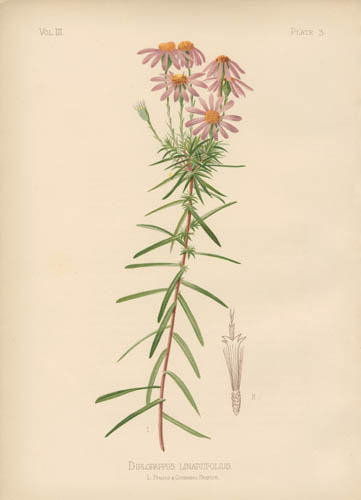South of the lighthouse
the savory-leaved aster
on a steep hillside.
That common rigid
narrow-leaved faint-purplish
aster in dry woods.
July 7. Just south of the lighthouse near the bank on a steep hillside, the savory-leaved aster (Diplopappus linariifolius) and mouse-ear (Gnaphalium plantaginifolium) form a dense sward, being short and thick; the aster not yet out. July 7, 1855
July 26. Diplopappus linariifolius. Aster dumosus. July 26, 1854
July 28. Aster linariifolius. July 28, 1853
July 29. That common rigid narrow-leaved faint-purplish aster in dry woods by shrub oak path, Aster linariifolius of Bigelow, but it is not savory leaved. I do not find it in Gray. July 29, 1852
August 3. Savory-leaved aster. August 3, 1858
August 4. The yellow Bethlehem-star still, and the yellow gerardia, and a bluish "savory-leaved aster." August 4, 1851
August 16. Diplopappus linariifolius, apparently several days. August 16, 1856
August 22. The savory-leaved aster (Diplopappus linariifolius) out; how long? August 22, 1859
August 30. As I went along from the Minott house to the Bidens Brook, I was quite bewildered by the beauty and variety of the asters, now in their prime there – A. lævis (large and handsome with various leaves), patens, linariifolius, etc. Why so many asters and goldenrods now? The sun has shone on the earth, and the goldenrod is his fruit. The stars, too, have shone on it, and the asters are their fruit. August 30, 1853
September 1. D. linariifolius, hardly noticed. September 1, 1856
September 2. Diplopappus linariifolius, quite common . . . D. linariifolius, pale bluish-purple (Some, outdoors, have a lilac or violet tint.) . . . The D. linariifolius is interesting, with its commonly single flower, with very broad rays turned backward, or handsomer still when it has fifteen or twenty heads crowded together. September 2, 1853
September 7. At Brattleboro, Vt . . .The Solidago Canadensis, and the smooth three-ribbed one, and nemoralis, etc., the helianthus (apparently decapetalus), and Aster or Diplopappus linariifolius, Vitis cordifolius (?) (now beginning to be ripe) are quite common along the bank. September 7, 1856
September 10. Diplopappus linariifolius and Aster undulatus apparently now in prime. September 10, 1854
September 24. D. linariifolius, in prime, abundant. September 24, 1856
September 29. Diplopappus linariifolius, Aster undulatus, and a few small ones September 29,1853
September 30. We then took the path to Clematis Brook on the north of Mt. Misery, where we found a few of the Diplopappus linariifolius (savory-leaved aster) and one or two small white (bushy ?) asters, also A. undulatus September 30, 1852
October 8. D. linariifolius, apparently nearly done October 8, 1856
October 10. Pulling up some Diplopappus linariifolius, now done, I find many bright-purple shoots, a half to three quarters of an inch long, freshly put forth underground and ready to turn upward and form new plants in the spring. October 10, 1858
October 12. With man all is uncertainty. He does not confidently look forward to another spring. But examine the root of the savory-leaved aster, and you will find the new shoots, fair purple shoots, which are to curve upward and bear the next year’s flowers, already grown half an inch or more in earth. Nature is confident. October 12, 1858
October 16. Many Diplopappus linariifolius are gone to seed, and yellowish globes. Such are the stages in the year's decline. The flowers are at the mercy of the frosts. October 16, 1859
October 20. Many plants which in the summer show a few red or scarlet leaves at length are all yellow only . . . Diplopappus linariifolius in shade yellow, in sun purple last of October October 20, 1858
October 22. I see the small narrow leaves of the Aster dumosus and also the yet finer ones of the Diplopappus linariifolius in wood-paths, turned a clear light-yellow. October 22, 1858
October 23. One Diplopappus linariifolius in bloom, its leaves all yellow or red. This and A. undulatus the asters seen to-day. October 23, 1853
October 25. Aster longifolius in low ground (a few). This and the Diplopappus linariifolius, and, above all, A. undulatus, the only flowers of the kind seen this week. (Afterwards A. puniceus, Tradescanti, and one lævis!) October 25, 1853
November 7. The Diplopappus linariifolius, which was yellow in the shade, in open and sunny places is purple. November 7, 1858
December 26. After snow, rain, and hail yesterday and last night, we have this morning quite a glaze, there being at last an inch or two of crusted snow on the ground, the most we have had . . .Weeds in the fields and the wood-paths are the most interesting. Here are asters, savory-leaved, whose flat imbricated calyxes, three quarters of an inch over, are surmounted and inclosed in a perfectly transparent icebutton, like a glass knob, through which you see the reflections of the brown calyx. December 26, 1855
Aster linariifolius and Diplopappus linariifolius — Savory-leaved aster, Flax-leaved stiff-aster , Stiff-leafed Aster, Sandpaper Aster or Sandpaper Starwort (now classified as Lonactis linariifolia)
See also
A Book of the Seasons, by Henry Thoreau, Asters in August
A Book of the Seasons, by Henry Thoreau, Savory-leaved aster
A Book of the Seasons, by Henry Thoreau
"A book, each page written in its own season,
out-of-doors, in its own locality."
~edited, assembled and rewritten by zphx © 2009-2025










